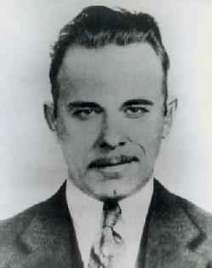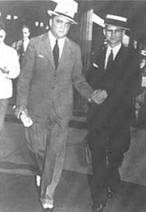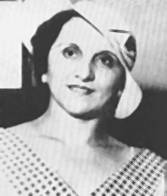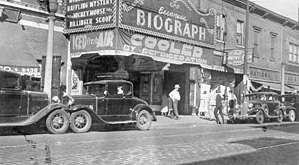|
|
|
 |
|
John Dillinger"Never trust a woman or
| |
|
Johnnie should have taken his own advice, because it was a woman,
the legendary "Woman in Red" who betrayed him. |
 |
The Dillinger gang's crime spree only lasted from September 1933 to July 1934, but during that time they killed 10 men, wounded 7, robbed 10 banks and staged three jail breaks. FBI Director J Edgar Hoover called him Public Enemy Number One, but in an age when some bank robbers were considered popular heroes, he became a romantic figure almost like a Robin Hood. Of course there was at least one major difference between John Dillinger and Robin Hood; Johnnie took from the rich all right, but he didn't believe in giving it to the poor. John Herbert Dillinger was born in 1903 in Indianapolis. His mother died when he was three and his father remarried when he was nine. Johnnie hated his stepmother. His father was a strict disciplinarian but was also very inconsistent. He might beat his son with a barrel stave one day and overindulge him the next.
Johnnie dropped out of school when he was sixteen and went to work in a machine shop. He was a hard worker and did well at his job, but he would often stay out late at night. Johnnie's father was very worried about the corrupting influence of the city on his son, so he moved from Indianapolis in 1920, and bought a farm in Mooresville, Indiana. Johnnie had no interest in farming. He kept his job in Indianapolis and continued to enjoy the city's nightlife and fast company. He was also committing petty crimes, and in 1923 his luck ran out when he was caught stealing a car. He was allowed to join the Navy in lieu of going to jail, but after only five months, Johnnie decided the Navy wasn't to his liking, so he went AWOL and returned to Indianapolis. In 1924, Johnnie and a friend robbed a grocer of $555. They were quickly caught and before the trial, Johnny's father was convinced by the prosecutor that the judge would be lenient with Johnnie if he pleaded guilty. Johnnie appeared in court without a lawyer or his father to support him - his father claimed he was "too busy" to attend the trial" and pled guilty. His reward for cooperating was a very harsh sentence; 10 to 20 years. His partner in crime didn't plead guilty and was convicted as well, but he ultimately served less than two years, despite the fact that he was older and had already served time for assault. Johnnie was very bitter about the long sentence he was given and even more bitter after he was denied parole after two years. In October 1933, Johnnie wrote his father a letter from jail: "I know I have been a big disappointment to you but I guess I did too much time, for where I went in a carefree boy, I came out bitter toward everything in general... if I had gotten off more leniently when I made my first mistake this would never have happened." While at the reformatory in Pendleton, Indiana, Johnnie met up with Harry Pierpont and Homer Van Meter. Pierpont had been convicted of bank robbery and Van Meter was caught robbing passengers on a train. Under their tutelage, Johnnie began his education in the finer points of being a career criminal. The three were split up when Pierpont and Van Meter were labeled as troublemakers and transferred to the prison at Michigan City Indiana, but Dillinger asked for and was granted a transfer there so he could stay with his pals. While at Michigan City, the trio met a very experienced bank robber named Walter Dietrich, who taught them his very successful method of robbing banks that relied on military-style precision. He taught them to plan out every movement in a robbery to the second, determine how long it would take for the police to respond, and in case of trouble to have alternate escape routes already mapped out. As the time approached for Dillinger to be paroled, they came up with a plan for a jailbreak that had Johnnie robbing a couple of banks after his release and then smuggling guns into the jail. Dillinger was paroled on May 22, 1933, after nine years and went right to work. The jailbreak was already set up when Johnnie managed to get himself arrested just 4 days before Pierpont and the others actually made their successful breakout. Dillinger had proven his loyalty to his friends and they didn't forget him. He was being held at the prison in Lima Ohio when Pierpont and the others arrived one day claiming to be Marshals sent to transfer Johnnie to another prison. When the Sheriff got suspicious and demanded to see their identification, they opened fire, mortally wounding him. They left the Sheriff to die, freed Johnnie and made their escape. Dillinger, Pierpont, Van Meter and several of the inmates that had escaped from Michigan City formed a gang that would later be known as the Dillinger gang. Pierpont actually ran the gang and he brought a sense of professionalism to their endeavors, not allowing any of them to drink alcohol for instance, because they had to be prepared at all times to avoid capture by authorities. It was Johnnie that the press and later the public became fascinated with though, because of his good looks, friendly banter, dapper clothes and penchant for athletic leaps over bank counters. They robbed banks all over the Midwest and brazenly stole guns, ammunition and bullet-proof vests from police departments. Many people followed the gang's exploits in the newspapers and Johnnie became something of a folk hero.
FBI Agents almost got Dillinger and his gang again when he was staying at the Little Bohemia Lodge in Rhinelander, Wisconsin. Agents wounded two and killed one innocent person whom they mistook for gang members. Once alerted, the gang shot their way out and all managed to escape. Lester Gillis, better known as "Baby Face Nelson" had recently joined the gang and during this confrontation he killed one lawman and wounded two others. This incident was a huge embarrassment to the FBI and Hoover was now more determined than ever to get the Dillinger gang. With the FBI hot on their trail, Dillinger and his gang, which now also included Charles Arthur "Pretty Boy" Floyd, continued to rob banks and shoot their way out of many traps. Dillinger was declared America's first Public Enemy Number One and a reward of $10,000 was offered for his capture. Eventually the heat was too much and gang had to split up. Under Hoover's orders, Agent Purvis began to systematically eliminate them one by one by tracking them down and killing them. Pierpont was the only one who was captured and survived long enough to be executed in the electric chair. Most of the others, including Van Meter, Pretty Boy Floyd and Baby Face Nelson were cornered and gunned down. Because his increasing notoriety was making it more and more difficult for him to avoid the same fate, Dillinger underwent plastic surgery on May 27, 1934. Perhaps Johnnie should have taken the doctor's name (Loeser, pronounced "loser") as a bad omen. He nearly died on the operating table from suffocation after his tongue swelled up when the doctor used too much ether, but Loeser was able to revive him and continue the operation. Johnnie's friends said they didn't see much difference, except that he now looked like he had the mumps. A few days later, Doctor Loeser went to work on Johnnie's fingertips in an attempt to change his fingerprints, but (as later fingerprinting by the police would show) that was a failure as well. Enter Anna Sage, who would later become infamous as "The Woman in Red." Sage had immigrated from Romania and was trying to avoid deportation after arrests for operating several brothels. Johnnie moved into Sage's Chicago apartment in July and within three weeks Sage had sold him out.
She contacted authorities and told them that Dillinger would be at the Biograph Theatre that night to see Manhattan Melodrama. She promised to wear a red dress so she would be easily identified. FBI agents gunned Dillinger down after Melvin Purvis identified him as he left the theatre with a girl on each arm"one of whom was Anna Sage.
|
|







